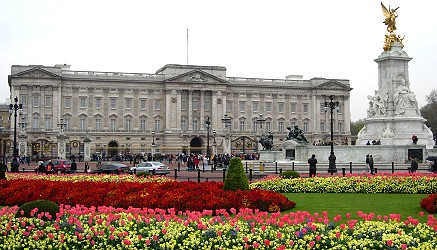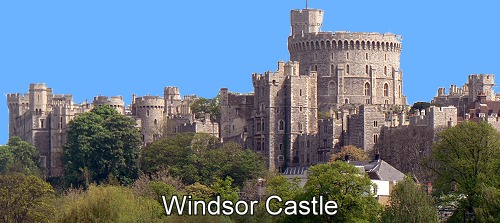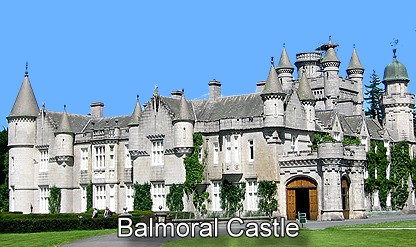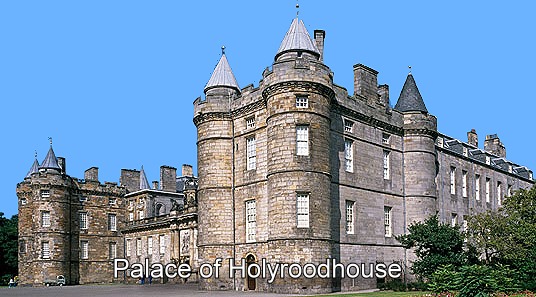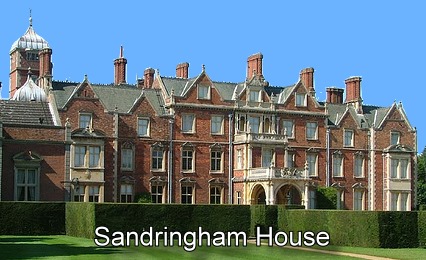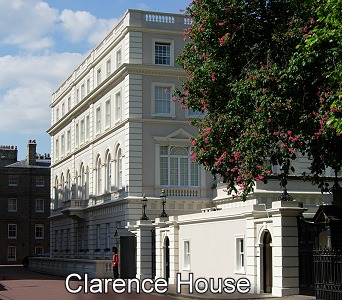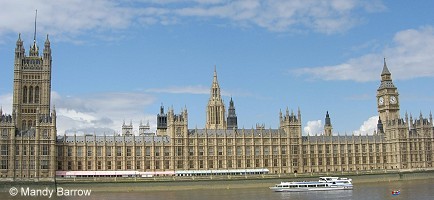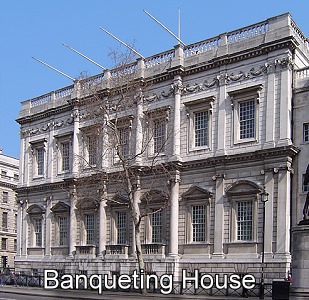 Project Britain
Project Britain
British Life and Culture
by Mandy Barrow
- Search our Site
- Project Britain
- Calendars
- Facts and figures
- London
- Great Britain
- Union Flag
- A-Z of Britain
- Customs & traditions
- Britain today
- Daily Life
- Money
- Etiquette
- Monarchy
- Government
- Education
- Tourist Information
- Food and drink
- Sports and leisure
- History
- Kings and Queens
- Superstitions
- Glossary
|
Royal Palaces and Castles
|
|
|
The word castle comes from a Latin word meaning fortress. The official London residences of the English Sovereigns, from Henry VIII to the present day, have been:
Interesting fact: The Queen's Homes Buckingham Palace Buckingham Palace is the Queen's official and main royal London home, although the Queen regularly spends time at Windsor Castle and Balmoral in Scotland.
We have now created a special page with photographas and information on Buckingham Palace. Click here to go there Windsor Castle Windsor Castle is an official residence of The Queen and the largest occupied castle in the world. The castle was the inspiration for the Royal family's surname.
William the Conqueror built the castle in 1080 and it has remained a royal palace and fortress for over 900 years. Windsor is the oldest royal home in Britain and, covering 13 acres, it's the largest castle in the world that is still lived in. Each year, the Order of the Garter ceremony is held at Windsor Castle, and the Queen occasionally hosts a "dine and sleeps" for politicians and public figures. Balmoral Castle Balmoral Castle is the private residence of The Queen. It has remained a favourite residence for The Queen and her family during the summer holiday period in August and September. The Castle is located on the large Balmoral Estate in Aberdeenshire, Scotland.
Some 85,000 people visit Balmoral each year, and the estate maintains and restores footpaths throughout the property for visiting hikers. The Palace of Holyroodhouse Founded as a monastery in 1128, the Palace of Holyroodhouse in Edinburgh is The Queen's official residence in Scotland. It was also the home of many Scottish royals.
The Queen holds receptions, state functions, and investitures within its walls, and each year during Holyrood Week Queen Elizabeth and Prince Philip invite 8,000 Scottish guests to the Garden Party. Sandringham House The Royal family’s private country retreat in Norfolk. Every Christmas is spent at Sandringham House, which has been the private home of four generations of sovereigns since 1862.
Other Royal Family Homes Kensington Palace Kensington Palace was the favourite residence of successive sovereigns until the death of George II in 1760.
When William III bought the Jacobean mansion in 1689 it was known as the Nottingham House. Kensington Palace was the birthplace and childhood home of Queen Victoria and her primary residence until she moved into Buckingham Palace. Kensington Palace was the London residence of the late Princess Diana. St. James Palace St. James's Palace was built between 1531 and 1536 and was home of kings and queens of England for over 300 years. The palace was built by Henry VIII on the site of the Hospital of St. James, Westminster.
After the destruction by fire of the Palace of Whitehall in 1698, all monarchs until William IV lived at St. James's for part of the time. William IV was the last Sovereign to use St. James's Palace as a residence. Since the accession of Queen Victoria in 1837, the Sovereign has lived at Buckingham Palace. Clarence House Clarence House, stands beside St James's Palace. It is The Prince of Wales's current official London residence and former London residence of the late Queen Elizabeth the Queen Mother.
Past Royal Homes Houses of Parliament (Palace of Westminster) Edward the Confessor made the Palace of Westminster the first official London residence. It is now the seat of British democracy. It is where the UK government is. The Palace contains over 1,000 rooms, the most important of which are the Chambers of the House of Lords and of the House of Commons.
The Banqueting House (Whitehall Palace) In 1529, Henry Vlll got fed up with Westminster Palace and built himself another one which he called Whitehall Palace. It covered 23 acres and it was the official royal residence until it burned down in 1698. It was rebuilt as government offices.
Hampton Court Palace Residence of King Henry VIII and Cardinal Wolsey. Tower of London The palace was a residence for Mary I and Elizabeth I, Charles I, William III and Mary II. Lambeth Palace Residence of the Archbishop of Canterbury. Castles
|
|
 © Copyright - please read © Copyright - please read All the materials on these pages are free for homework and classroom use only. You may not redistribute, sell or place the content of this page on any other website or blog without written permission from the Mandy Barrow. |
© Copyright Mandy Barrow 2014
Mandy is the creator of the Woodlands Resources section of the Woodlands Junior website.
The two websites projectbritain.com and primaryhomeworkhelp.co.uk are the new homes for the Woodlands Resources.
Mandy left Woodlands in 2003 to work in Kent schools as an ICT Consultant.
She now teaches computers at The Granville School and St. John's Primary School in Sevenoaks Kent.
Woodlands Junior Homework Help new website
